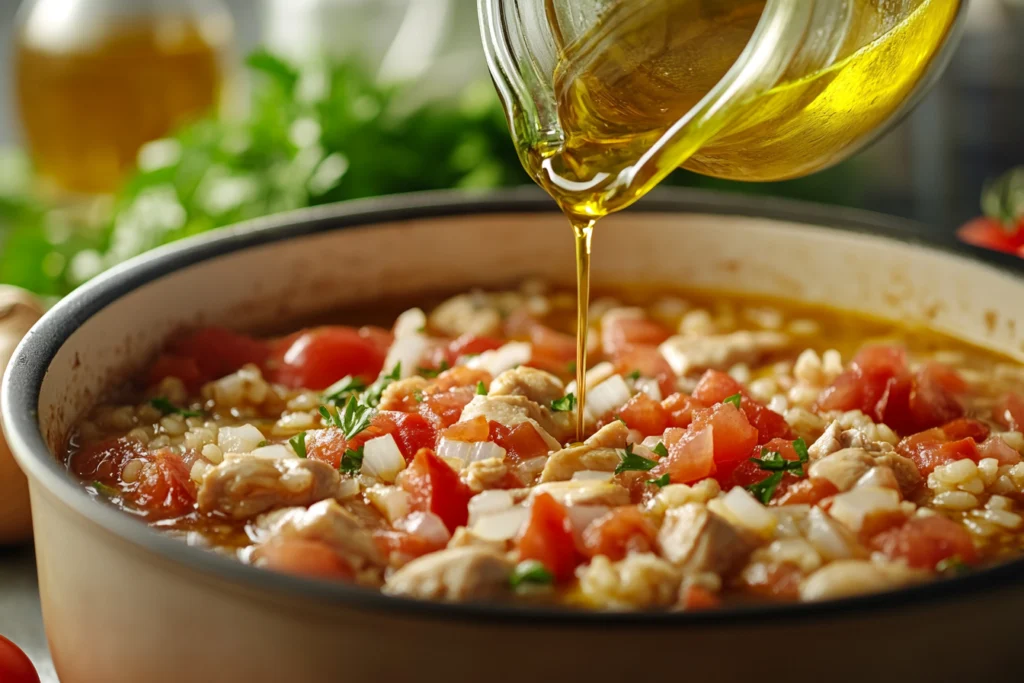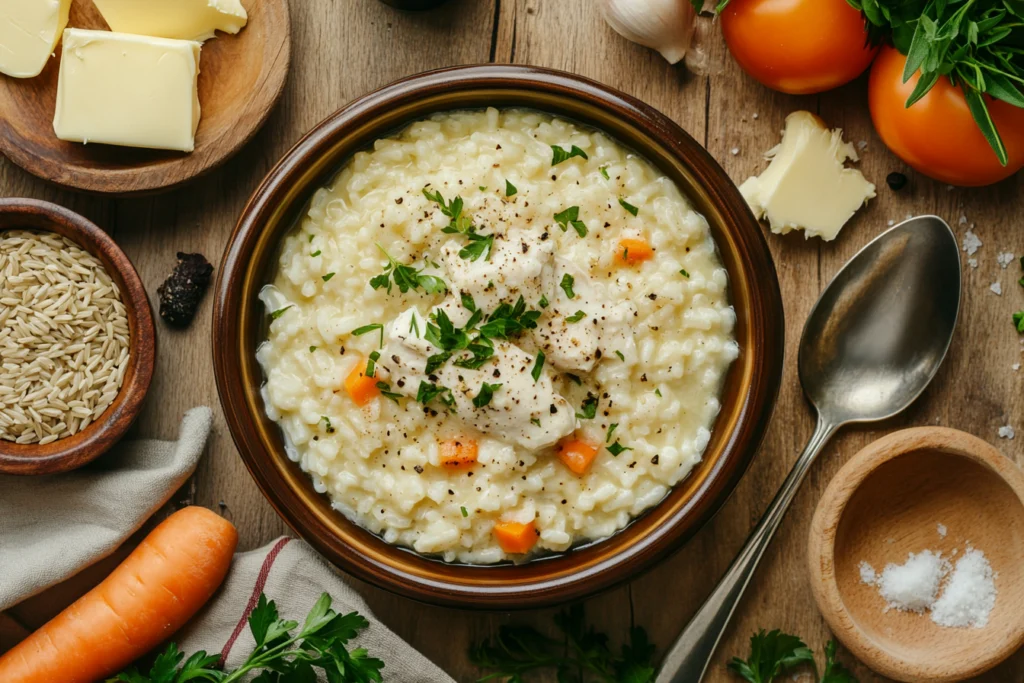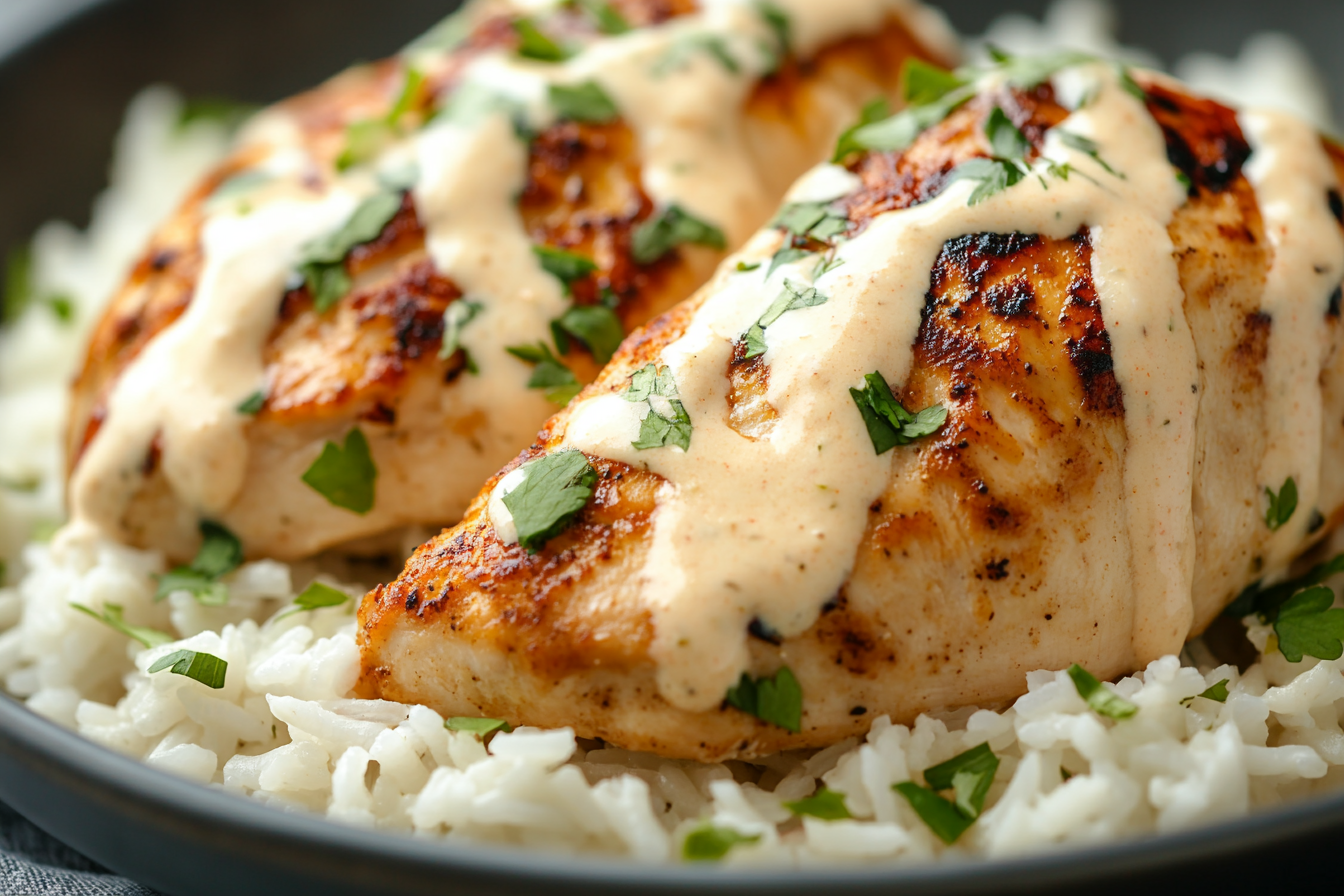What Can I Add to Chicken and Rice to Make It Less Dry? Chicken and rice are timeless comfort foods, but let’s face it—sometimes they can turn out dry, bland, and uninspiring. Whether you’re cooking for meal prep, a family dinner, or whipping up a quick lunch, nailing the juiciness factor can transform your dish from boring to brilliant. This article dives deep into simple but effective ways to make your chicken and rice moist, flavorful, and utterly satisfying.
We’ll explore kitchen staples like broth, rich marinades, creamy sauces, and even quick fixes like fresh toppings. Plus, we’ll touch on some game-changing cooking techniques that you might’ve overlooked. Ready to transform your dry meals into drool-worthy dinners? Let’s get started!
Understanding the Problem
Why Do Chicken and Rice Dishes Turn Out Dry?
Ever wonder why your chicken and rice come out dry as a bone even though you followed the recipe to a T? There are a few common culprits behind this disappointing outcome.
Common Cooking Mistakes:
One of the main reasons is overcooking. Chicken breasts, in particular, are lean and can dry out quickly without enough moisture or fat. Rice, on the other hand, can turn into a starchy mess or a crunchy disaster if the water-to-rice ratio isn’t right.
The Science Behind Moisture Retention:
Moisture is all about balance. Rice needs enough liquid to absorb and plump up without becoming sticky. Chicken needs to retain its juices or absorb flavors from the outside. When either one loses too much steam—literally—the texture suffers.
Identifying the Key Culprits
Low-Fat Content in Chicken:
Boneless, skinless chicken breasts are notorious for drying out because they don’t have that extra fat that thighs or drumsticks do.
Incorrect Rice-to-Water Ratio:
This one’s a biggie! Too little water, and your rice will be undercooked and dry. Too much, and you’re left with mushy clumps.
Cooking Without a Lid or Foil:
Ever cooked rice or chicken without covering it? That’s like asking the steam to escape. Covering your pan with foil or using a tight-fitting lid traps the moisture and makes all the difference.

Simple Additions to Enhance Moisture
Moisture-Rich Ingredients to Add
When your chicken and rice feel more like a dry chore than a delicious dish, the right add-ins can be game-changers. You don’t need anything fancy—just a few pantry staples and fresh ideas to make your meal juicy and flavorful.
Broth and Stock:
One of the easiest ways to infuse moisture into chicken and rice is by cooking or reheating them in broth or stock. Chicken broth, vegetable broth, or even bone broth can add layers of flavor while keeping everything moist.
- Tip: Use broth instead of plain water when cooking rice for a richer, well-rounded taste.
- Pro Move: Pour a small amount of warm broth over your cooked chicken before serving—it soaks right in!
Creamy Sauces:
Adding a creamy element takes your dish from basic to indulgent. Think creamy coconut milk, a light béchamel, or a tangy yogurt-based sauce. These options coat your chicken and rice in moisture.
- Coconut milk works wonders in rice, especially if you’re making a dish with a tropical or curry-inspired twist.
- Greek yogurt mixed with lemon, garlic, and a touch of olive oil makes a tangy topping for cooked chicken.
Vegetables:
Surprisingly, vegetables can work double duty. They release moisture as they cook and add extra nutrients and flavors.
- Best Veggies: Zucchini, tomatoes, and spinach release water and absorb seasonings beautifully.
- How-to: Dice the veggies and sauté them with olive oil before adding them to your rice. You’ll notice how your dish feels fresher and less dry.
Incorporating Fats and Oils
Fats are the secret to succulent chicken and fluffy rice. A drizzle of healthy oil or a pat of butter can make all the difference.
Butter and Margarine:
Adding a small knob of butter while your rice is still hot helps lock in moisture and adds a rich, comforting taste.
Olive Oil and Flavorful Oils:
Olive oil isn’t just for sautéing—it can also be drizzled over cooked chicken for a subtle, savory finish. You can also try infused oils (like garlic or basil-infused olive oil) for an extra flavor punch.
Advanced Techniques for Juicier Chicken and Rice
Marinades and Brines for Chicken
One of the best ways to ensure your chicken stays moist is by prepping it with marinades and brines before cooking. These techniques add flavor while helping the meat retain its natural juices.
Marinades:
Marinating chicken infuses it with flavors and prevents it from drying out during cooking. A good marinade has three key components:
- Acid: Lemon juice, vinegar, or yogurt breaks down the fibers and tenderizes the meat.
- Fat: Olive oil or coconut milk adds richness and locks in moisture.
- Flavor Boosters: Garlic, herbs, soy sauce, or spices bring it all together.
Pro Tip: Marinate your chicken for at least 30 minutes, but if you can spare a few hours or even overnight, the difference will be mind-blowing.
Brines:
Brining is another tried-and-true method for juicy chicken. It’s especially great for lean cuts like chicken breasts. A brine is essentially a salty solution that helps the chicken absorb water, making it juicier after cooking.
Basic Brine Recipe:
- 4 cups of water
- ¼ cup of salt
- 2 tablespoons of sugar (optional, but it helps balance the saltiness)
Let the chicken sit in the brine for 1–2 hours, then rinse and pat it dry before cooking.
Cooking Methods That Lock in Moisture
Even with the perfect marinade or brine, your cooking method can make or break the dish. Here are some techniques to keep things juicy:
Slow Cooker or Pressure Cooker:
Using a slow cooker or an Instant Pot can do wonders for chicken and rice. The slow, steady heat or pressure traps moisture and enhances the flavors.
- In a slow cooker, set it on low for longer cooking times to prevent overcooking.
- In an Instant Pot, the sealed environment prevents moisture loss, so your chicken comes out tender and flavorful.
Baking with Foil or Lid:
When baking, make sure to cover your dish with foil or a lid to keep the steam inside. This trick works like magic, especially for baked chicken and rice casseroles.
Stir-Frying:
For quick, moisture-rich meals, stir-frying is your best friend. Cooking the chicken and rice quickly over high heat with a splash of broth or sauce ensures the ingredients stay moist and don’t dry out.

Flavorful Enhancements
Once you’ve nailed the moisture, it’s time to level up with bold flavors that turn your chicken and rice into a crave-worthy dish. From spices to toppings, small additions can pack a big punch.
Adding Spices and Seasonings
Seasonings not only add flavor but can also help lock in moisture when applied properly. Here’s how to do it right:
Blend of Spices:
A balanced spice blend elevates your dish. Try mixing garlic powder, onion powder, smoked paprika, and a dash of cayenne for a warm, smoky flavor.
- Tip: Season your chicken and rice generously before and during cooking—not just after!
Avoiding Overpowering Flavors:
It’s tempting to throw in a bit of everything, but too many spices can overwhelm the natural taste of the chicken and rice. Stick to complementary spices and adjust as you go.
Topping Ideas for Added Moisture
Toppings can completely transform a meal. Not only do they add visual appeal, but they also introduce extra moisture and flavor.
Cheese Options:
- Shredded Cheddar: Adds a sharp, creamy layer that melts beautifully into the rice.
- Mozzarella: Perfect for a gooey, stretchy texture.
- Parmesan: A little goes a long way—its salty, nutty flavor pairs well with buttery rice.
Salsas and Sauces:
A spoonful of fresh salsa, pesto, or chutney can instantly moisten dry chicken and add vibrant flavor.
- Fresh tomato salsa with lime and cilantro brightens up the dish.
- Pesto adds a rich, herby punch—perfect for Mediterranean-inspired meals.
Fresh Herbs:
Never underestimate the power of herbs. A sprinkle of parsley, cilantro, or green onions adds freshness and a pop of color to your plate.
- Tip: Add the herbs right before serving so they stay crisp and flavorful.
Creating Balanced Meals
Making sure your chicken and rice dish isn’t dry is only part of the solution. Pairing it with the right side dishes and balancing the flavors can take your meal to the next level.
Pairing Chicken and Rice with Side Dishes
Side dishes that complement chicken and rice should be flavorful, hydrating, and texturally interesting. The following ideas will help you finish your meal:
Moisture-Heavy Sides:
- Coleslaw: The creamy dressing adds a refreshing crunch and moisture.
- Sautéed Greens: Spinach, kale, or Swiss chard cooked with garlic and a splash of olive oil stay tender and flavorful.
- Roasted Vegetables: Roasted carrots, zucchini, or bell peppers release natural juices that pair beautifully with chicken and rice.
Refreshing Salad Ideas:
A simple salad can lighten the meal while balancing the richness of creamy sauces and buttery rice.
- A cucumber and tomato salad with olive oil and lemon adds brightness.
- For something heartier, try a quinoa salad with fresh herbs and feta.
Nutritional Considerations
You can make your chicken and rice moist and flavorful without overloading it with unhealthy fats. Here are some tips for balancing nutrition:
Balancing Macronutrients:
- Add a protein-rich topping like chickpeas or shredded chicken thighs.
- Include a small amount of healthy fats, like avocado or olive oil, to keep the dish satisfying.
Healthy Substitutions:
- Use coconut milk or Greek yogurt in place of heavy cream.
- Swap white rice for brown rice or cauliflower rice if you’re looking for more fiber or a low-carb option.
Frequently Asked Questions
When it comes to making chicken and rice less dry, there are always questions that pop up. To help you perfect your cuisine, here are answers to some of the most common questions.
What is the best sauce to use for chicken and rice?
The best sauce depends on the flavor profile you’re going for. Creamy sauces like béchamel, coconut curry, or yogurt-based sauces work great for locking in moisture. If you prefer something lighter, opt for vinaigrettes or tomato-based sauces like salsa or marinara.
Pro Tip: A drizzle of warm broth or gravy over your rice and chicken just before serving can add extra moisture without overpowering the flavors.
Can I fix dry chicken and rice after it’s cooked?
Absolutely! Here’s how:
- For chicken: Shred the dry chicken and mix it with a little warm broth or sauce.
- For rice: Add a splash of broth, cover it with a lid, and let it steam over low heat for a few minutes.
- You can also stir in a bit of butter or olive oil to add richness and moisture.
How can I prevent chicken and rice from drying out in the future?
- To prevent the chicken from being overcooked, use a meat thermometer.
- Cook the rice with broth instead of water and follow the correct water-to-rice ratio.
- Cover your baking dishes or use sealed cookware to trap steam and moisture.
Are there low-fat options to keep chicken and rice moist?
Yes! Low-fat options include:
- Greek yogurt: Adds tang and creaminess without a lot of fat.
- Vegetable-based sauces: Pureed roasted vegetables like tomatoes or bell peppers can act as a flavorful, low-fat sauce.
- Coconut milk (light): Provides creaminess without being too heavy.
Can leftover chicken and rice be rehydrated?
Yes, leftovers can be saved! Add a small amount of liquid (broth, sauce, or even water), cover the dish, and reheat in the oven or microwave.
- In the microwave, use 50% power to avoid overcooking while reheating.
- Stir occasionally to distribute the heat evenly.
What vegetables are best for adding moisture to chicken and rice?
Vegetables that release a lot of moisture as they cook are ideal:
- Tomatoes: Juicy and tangy, they bring both moisture and acidity.
- Zucchini and squash: Soft and hydrating, they melt into the dish as they cook.
- Spinach and kale: They wilt easily, releasing their natural juices without making the dish watery.
Wrapping It Up
By now, you’ve learned how to turn your dry chicken and rice into a flavorful, juicy masterpiece. From rich broths and creamy sauces to smart cooking techniques and refreshing toppings, each step builds a better, more balanced dish.
Key Takeaways:
- The right broth-to-rice ratio and using marinades or brines for chicken can prevent dryness from the start.
- Cooking with lids or foil traps essential moisture, making your meals tender and flavorful.
- Adding moisture-rich vegetables like tomatoes and zucchini, along with fresh toppings like pesto or salsa, brings both hydration and bold flavors.
- Don’t forget to experiment with low-fat options like Greek yogurt, light coconut milk, or pureed veggies for healthier yet creamy results.
Final Tip:
Cooking is all about trial and error—and a little creativity. If your chicken and rice dish doesn’t turn out perfectly moist the first time, don’t sweat it! Incorporating just a few of these tips can make a noticeable difference. So, keep experimenting, taste as you go, and soon you’ll master the art of moist, flavorful chicken and rice.


1 thought on “12 Delicious Ways to Add Moisture to Chicken and Rice for Juicy Perfection”